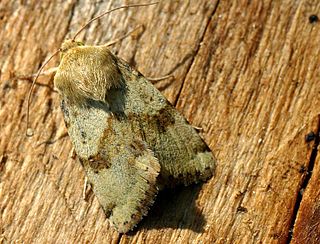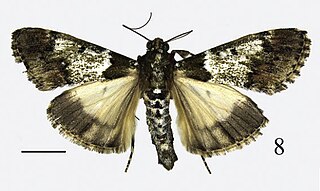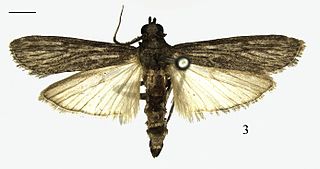
Hasora badra, the common awl, is a butterfly belonging to the family Hesperiidae, which is found in India.

The band-winged nightjar or greater band-winged nightjar is a species of nightjar in the family Caprimulgidae. It is widespread in South America, where it is found in the Andes, Venezuelan Coastal Range, Santa Marta Mountains, Tepuis, most of Chile, Argentina, Paraguay, Uruguay, and eastern Brazil. It occurs in a wide range of habitats, from the edge of humid montane forests to shrubby semi-deserts and urban rooftops.

The white-fronted surili is a species of primate in the family Cercopithecidae, the Old World monkeys. It is endemic to the large international island of Borneo, in Indonesia, Malaysia, and possibly Brunei.

Heliothis viriplaca, the marbled clover, is a moth of the family Noctuoidea. It is found in Europe and across the Palearctic to Central Asia then to Japan, Korea and Sakhalin. In the south, it penetrates to Kashmir and Myanmar. As a migratory moth, it also reaches areas in northern Fennoscandia in some years. North of the Alps, both indigenous and immigrant individuals occur in certain areas. The heat-loving species occurs mainly on dry grasslands, fallow land, heathlands and sunny slopes and slopes and the edges of sand and gravel pits.

Halolaguna is a genus of moth in the family Lecithoceridae.
Neopectinimura beckeri is a moth in the family Lecithoceridae. It is found in Papua New Guinea.

Cochylichroa atricapitana, the black-headed conch, is a moth of the family Tortricidae. It is found in China (Xinjiang) and the eastern Palearctic and most of Europe.
Athymoris subtrigona is a moth in the family Lecithoceridae. It is endemic to Taiwan.
Athymoris phreatosa is a moth in the family Lecithoceridae. It is found in China (Sichuan) and Taiwan.
Halolaguna palinensis is a moth in the family Lecithoceridae. It is endemic to Taiwan.

Ichneutica morosa is a moth of the family Noctuidae. It is endemic to New Zealand and is found in the southern parts of the North Island and throughout the South Island. I. morosa is common in the eastern parts of both those islands and also in Fiordland. I. morosa can be found from altitudes ranging from lowlands to the alpine zone. I. morosa is absent from the range of its closely related species I. mustulenta, that is from the northern North Island. The larvae of I. morosa are known to feed on Poa astonii and also on other Poa species including introduced species. As well as its standard form the adult moths have a grey colour morph with the head and thorax being a grey and mottled brown, and the forewing being a pale greyish ochreous to a deep brown, suffused with grey. I. morosa can be confused with I. mustulenta and I. lignana. Adults are on the wing from November to April.

Halolaguna flabellata is a moth in the family Lecithoceridae. It is found in Guangxi, China.
Halolaguna discoidea is a moth in the family Lecithoceridae. It is found on Borneo.
Pectinimura brahmanica is a moth in the family Lecithoceridae. It is found in Papua New Guinea.

Teliphasa spinosa is a species of moth of the family Pyralidae. It is found in China (Yunnan).

Teliphasa similalbifusa is a species of moth of the family Pyralidae. It is found in China (Guangxi).

Teliphasa erythrina is a species of moth of the family Pyralidae. It is found in China (Yunnan).
Deltoplastis cognata is a moth in the family Lecithoceridae. It was described by Chun-Sheng Wu and Kyu-Tek Park in 1998. It is found in Sri Lanka.

Teliphasa hamata is a species of moth of the family Pyralidae. It is found in China.

Ectomyelois bipectinalis is a species of snout moth. It is found in China.













